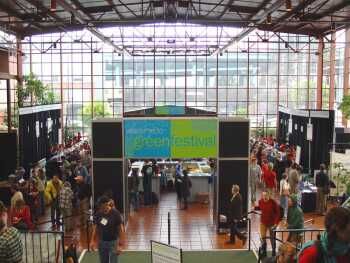
Publisher:
Bonnie King
CONTACT:
Newsroom@Salem-news.com
Advertising:
Adsales@Salem-news.com

~Truth~
~Justice~
~Peace~
TJP
Feb-16-2008 19:31

 TweetFollow @OregonNews
TweetFollow @OregonNews
Green Festivals are Coming Up Like Daisies This Spring
Salem-News.com EARTH TALKLandscaping in "earth friendly" ways and finding Earth Day festivals worthy of your green.
 Entrance to the November 2006 Green Festival held at the Concourse Exhibition Center in San Francisco. Photo: Franco Folini |
(SALEM, Ore.) - Dear EarthTalk: I've been reading about various green festivals going on around the country and I want to attend some and get up to speed on environmental issues and products. What are some good ones and how do I stay on top of all the wheres and whens? -- Alex, Chicago, IL
 ET: Whether you’re a consumer in search of green products and healthy organic foods, an environmental advocate looking to network, or a businessperson who wants to “green up” operations, there is an environmental event out there for you.
ET: Whether you’re a consumer in search of green products and healthy organic foods, an environmental advocate looking to network, or a businessperson who wants to “green up” operations, there is an environmental event out there for you.
One of the best is the Green Festivals series, which appears in an increasing number of U.S. cities every year and is growing in leaps and bounds in attendance. Co-sponsored by two leading national nonprofits, Global Exchange and Co-Op America, these so-called “parties with a purpose” bring together businesses, environmental groups and community organizations working toward the collective goal of “forging a just, sustainable, inclusive economy—a green economy.”
Hundreds of thousands of people from all walks of life have participated in these festivals over the last decade to peruse aisles packed with exhibits, hear speakers, make connections with like-minded folks and indulge in green-themed music, art, culture and food. In 2008, events will take place in Seattle (April 12-13), Chicago (May 17-18), Washington, DC (November 8-9) and San Francisco (November 14-16).
Another event geared toward the green-leaning general public is EcoFest, held every September for the last two decades in New York City. This free event also features myriad commercial and nonprofit exhibits and celebrity speakers and performers. Attendees at EcoFest’s 2008 event will get to check out prototypes of alternative energy vehicles, watch a green-themed fashion show and participate in environmental education workshops, among other events.
One very educational event is the yearly DC Environmental Film Festival, which takes place March 11 – 22 this year in Washington. The festival features 115 documentary, feature, animated, archival, experimental and children's films, shown at various locations around Washington, including museums, libraries, embassies, universities and theatres. Most are free and many include discussions with the filmmakers and/or scientists and environmental leaders.
Many environmental festivals are broad with regard to topics covered, but several issue-specific and business-to-business events take place throughout the year as well. To key in to these events, go to the Green Fairs and Festivals page at the EcoBusinessLinks Environmental Directory. Examples include Texas’s Renewable Energy Roundup, Colorado’s Rocky Mountain Sustainable Living Fair, Georgia’s GreenBuild Expo, Vermont's SolarFest, and Croton-on-Hudson, New York’s Great Hudson River Revival, which has been raising funds to protect New York’s Hudson River since the late 1970s.
Green events take place all year long, but a large number happen in the spring to coincide with Earth Day (April 22). Many school and community environmental groups hold Earth Day events every year. To find an Earth Day event near you this coming spring, consult Earth Day Network’s free online database: Earth Day Network Dear EarthTalk: Is it possible to landscape my property in a green-friendly way? I would like to create a more natural and wildlife-friendly backyard, but I don’t want to break the bank doing it. Are there any tax incentives for completing such projects? -- Michal Avraham, Olive Branch, MS
ET: One common misperception about adopting green practices around the home is that doing so will cost more money. But this may be true only in the short run. There are certainly some up-front outlays to converting a conventional backyard into a more environmentally friendly space (like any landscaping job), but homeowners should be able to make their money back within a few years through savings on their water and yard service bills alone.
Landscapes designed with the principles of nature and wildlife habitat in mind are often referred to as “naturescapes” (or “xeriscapes” when they also require little water to maintain). They usually replace most lawn grass and instead populate space with native plants that are attractive to wildlife for food or shelter.
According to the nonprofit PlantNative, maintaining a green backyard can cost up to 90 percent less than keeping up a traditional lawn-based landscape. “Since naturescapes effectively take care of themselves, there is little or no maintenance and hence little or no maintenance cost,” says the group. The average American lawn costs about $700 yearly to maintain, says PlantNative, which also points out that the average household lawnmower is used upwards of 40 hours a year, the equivalent of a full work week.
Melissa Santiago, a researcher with Ohio State University who authored a fact sheet on the benefits of managing property for wildlife, couldn’t agree more: “Maintaining wildlife habitat or other natural areas can be a cost-effective approach to land management.”
She recommends that landowners with room to spare plant one or more rows of native trees and shrubs as so-called “shelterbelts” that provide wildlife habitat and also provide shade in summer (to reduce air conditioning costs) and wind resistance in winter (they have been shown to reduce heating costs by as much as 30 percent).
Tax breaks for greening up your residential landscape are few and far between, but do exist. The state of Indiana offers tax breaks to landowners who convert a minimum of 15 acres over to habitat suitable for native wildlife. Many other state governments offer landowners similar assistance for maintaining habitat for threatened wildlife. And municipalities across the arid southwestern U.S. offer various incentives for homeowners who cut water use, whether through xeriscaping or any other means.
To get started converting your yard over, contact a local nursery well-versed in native landscaping to lend some informal or professional expertise. To find a nursery in your area that fits the bill, consult PlantNative’s free online directory of native plant nurseries.
Or, if you want to do your own homework, check out the National Wildlife Federation’s free online Native Plant Guide (which covers the 50 U.S. states) or the Canadian Wildlife Federation’s guidebook Backyard Habitat for Canada’s Wildlife (available in print for $19.95 plus shipping).
GOT AN ENVIRONMENTAL QUESTION?
Send it to: EarthTalk, c/o E/The Environmental Magazine, P.O. Box 5098, Westport, CT 06881;
Or, Submit it at: www.emagazine.com/earthtalk/thisweek/;
Or, e-mail: earthtalk@emagazine.com.
Read past columns at: emagazine.com/earthtalk/archives.php.
Articles for February 15, 2008 | Articles for February 16, 2008 | Articles for February 17, 2008
Quick Links
DINING
Willamette UniversityGoudy Commons Cafe
Dine on the Queen
Willamette Queen Sternwheeler
MUST SEE SALEM
Oregon Capitol ToursCapitol History Gateway
Willamette River Ride
Willamette Queen Sternwheeler
Historic Home Tours:
Deepwood Museum
The Bush House
Gaiety Hollow Garden
AUCTIONS - APPRAISALS
Auction Masters & AppraisalsCONSTRUCTION SERVICES
Roofing and ContractingSheridan, Ore.
ONLINE SHOPPING
Special Occasion DressesAdvertise with Salem-News
Contact:AdSales@Salem-News.com

googlec507860f6901db00.html



Terms of Service | Privacy Policy
All comments and messages are approved by people and self promotional links or unacceptable comments are denied.
[Return to Top]
©2025 Salem-News.com. All opinions expressed in this article are those of the author and do not necessarily reflect those of Salem-News.com.